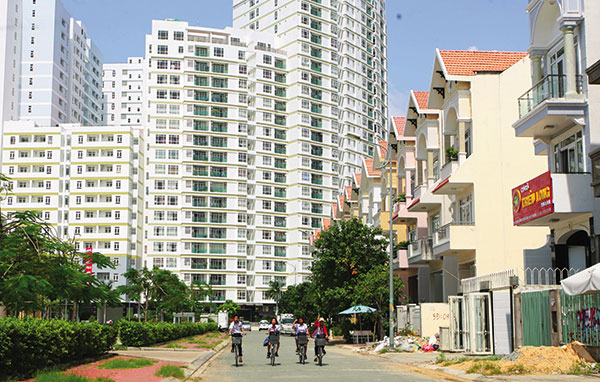FDI keeps sights on Ho Chi Minh City realty
 |
| Investment in Ho Chi Minh City’s property sector continues to reel in developers from Asia and further abroad |
In the first eight months of 2016, the city’s real estate sector attracted the most foreign direct investment, with capital of $318.9 million so far disbursed. Singapore is the top investor in the local real estate sector, followed by Japan and Korea.
Some notable investments pledged include the $226 million real estate project named Midtown by Cayman Islands and $6 billion Saigon Peninsula project by Pavilion Group, Genting Malaysia Berhad, and Vietnamese partner Van Thinh Phat.
Trang Le, manager of research at Jones Lang LaSalle Vietnam (JLL), told VIR that there is increased investment sentiment among foreign investors due to customer confidence and affordability of homebuyers, especially local cash-rich people.
In a recent report released by JLL Vietnam, Ho Chi Minh City’s residential supply is predicted to grow by 74 per cent over the next three years, but the market will be able to absorb it. The main reason is that demand driven by owner-occupation buyers will continue to be considerable, especially in low to mid-end projects. Buyers with investment purposes will still remain at good levels on the back of improving economic fundamentals.
Besides housing property, foreign investment funds continue to seek opportunities in office assets in prime Vietnamese locations, in particular in Ho Chi Minh City, as they expect a high growth of capital value and yield compression.
Ho Chi Minh City has 1.7 million square metres of office space, which is less than half that of Jakarta, Kuala Lumpur, Bangkok, and Manila. Demand for office space is forecast to grow by 8-10 per cent annually as the economy develops. This provides a great opportunity for developers to acquire sites to build more office space in the city.
Meanwhile, Ho Chi Minh City’s retail market remains attractive to foreign investors who would like to tap into a growing population of 90 million people and an expanding middle-class.
Last week, South Korea’s largest discount chain Emart announced that it would ink a memorandum of understanding (MoU) with the city to invest $200 million in the area. The MoU established a strategic partnership between the two parties to build giant retail outlets, supermarkets, and various other types of commercial facilities, according to Yonhap News Agency.
According to Kim Seong-young, who heads new businesses for E-Mart, the group expects to increase investment in Ho Chi Minh City, Vietnam’s economic centre, in various forms through this MoU. Ho Chi Minh City will be the base of its efforts to enlarge its Vietnamese market share.
“The ratification of the free trade agreements will increase foreign investors’ interest into Vietnam over the year. The fundamentals of this market are exceptional, with 60 per cent of the population under the age of 35, which is boosting interest regionally in the domestic fast-moving consumer goods sector. ASEAN Economic Community anticipation in late 2015 had Asia Pacific investors flocking to Vietnam,” said Ben Gray, director of capital markets for C&W Vietnam.
He further noted that regional investors in real estate are seeking stabilised income-producing assets to acquire in Vietnam. They continue to look to improve their portfolio returns and this is translating into increased interest into core products in the housing, office, retail, industrial, and hospitality sectors.
What the stars mean:
★ Poor ★ ★ Promising ★★★ Good ★★★★ Very good ★★★★★ Exceptional
Latest News
More News
- Unlocking urban potential of smart cities (December 18, 2025 | 16:50)
- Green finance offers 'passport' for Vietnamese construction, building materials firms (December 15, 2025 | 08:00)
- Gamuda Land commit long-term investment (December 12, 2025 | 11:49)
- HITC ties up with Evolution to develop AI and hyperscale data centres in Vietnam (December 11, 2025 | 12:09)
- Real estate deals boom via high-profile names (December 08, 2025 | 11:32)
- Industrial segment shaped by M&As (December 08, 2025 | 08:00)
- The Privé sets the benchmark for luxury real estate (December 05, 2025 | 08:28)
- TD CASA and the rise of bespoke interior design in luxury living spaces (December 03, 2025 | 14:14)
- Lee Soo-man's Blooming Sky to build Gia Lai culture, sport, and entertainment complex (December 02, 2025 | 16:41)
- Sustainability in DNA of Keppel Vietnam's future urban development strategy (November 28, 2025 | 10:53)
















 Mobile Version
Mobile Version